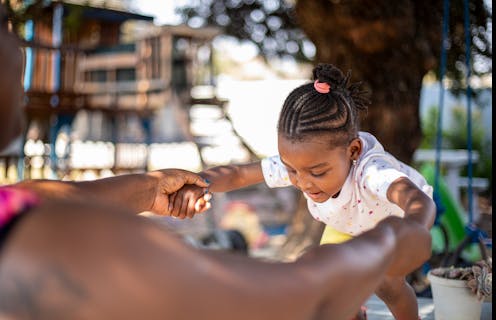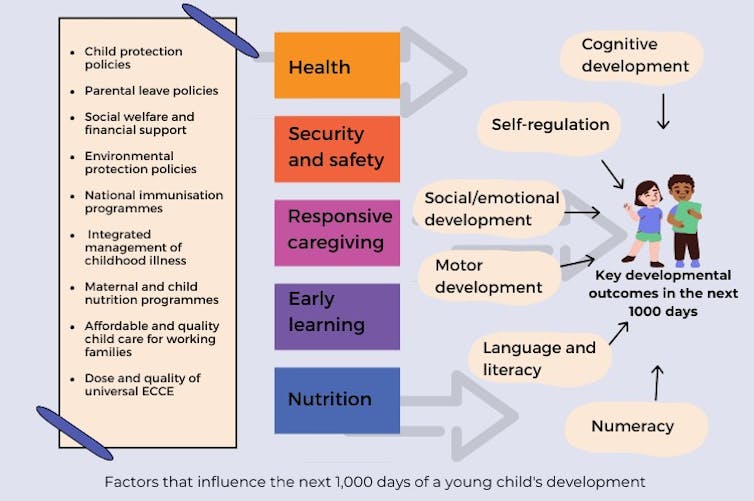
The first 1,000 days of a child’s life – pregnancy and the months leading to their second birthday – are a critical time. Expectant mothers need good antenatal care. The better their physical and mental health, the greater the likelihood of giving birth to a healthy baby and being able to nurture that baby through the first two years of life.
There’s a large global body of evidence to show that what happens during this period has lifelong effects on a person’s health, growth and well-being.
Less attention has been paid to the “next 1,000 days”, when children are between the ages of 2 and 5. But what public health and child development experts do know is that this, too, is a crucial time. Within this period, there are opportunities to build on investments made in the first 1,000 days, as well as to help put children who did not get the input they needed earlier in life back on track, setting them up for school and a healthy childhood and adolescence.
The Lancet, one of the world’s leading medical journals, has just launched a series of papers about these “next 1,000 days”, building on previous series in 2007, 2011 and 2016 on early childhood development. I am a public health specialist with expertise in early childhood development who led the series, working with experts from all over the world to highlight the latest scholarly evidence about this crucial window of time in children’s lives. We’ve focused particularly on low- and middle-income countries.
We wanted to highlight the latest available evidence on the next 1,000 days – why it is important, what influences development in this age group, what programmes are being implemented and are working, where children are falling behind, and the cost of not investing.
Read more: Child care centres in South Africa need more support: principals tell of pandemic impact
In the next 1,000 days, young children’s development is shaped by a range of influences. These include their physical health, developmental delays and disabilities, nutrition, parenting, exposure to violence, the mental health of their caregivers, father involvement, early childhood care and education environment, and exposure to pollution and climate change. The COVID-19 pandemic amplified many of the risks associated with these influences, making it more urgent than ever to reduce those risks.
Why do the next 1,000 days matter?

Between the ages of 2 and 5, children advance rapidly in a range of areas: cognitive development and self-regulation, as well as social, emotional, motor, language and numeracy skills. Of course, children develop these skills at different rates and in different ways. Promoting development in these areas sets young children on a path for health, development and education.
These paths are shaped by the quality of care in five areas: health, nutrition, responsive caregiving, safety and security, and early learning. Essentially, this nurturing care is what children need to thrive. The graphic below shows how these dimensions relate to developmental outcomes that matter in this age group, as well as important policies and programmes to guide their growth.

Lower- and middle-income countries: zooming in
A previous Lancet series about early childhood development reported that an estimated 250 million children under the age of 5 in lower- and middle-income countries were at risk of not reaching their developmental potential.
More recent data in the new series indicates that, in these countries, only 62 million children aged 3 and 4 (25%) currently receive the care they need to thrive. This leaves close to 182 million children exposed to risks that jeopardise their healthy development.
Access to adequate care varied systematically across regions. In sub-Saharan Africa the figure stood at just 7.9%. For children in lower- and middle-income countries in Europe and central Asia, it was 68%.
Read more: Economies grow when early childhood development is a priority
We also found that fewer than one in three children in low- and middle-income countries have access to developmental stimulation or are protected from physical punishment. Only 39% have access to early childhood care and education programmes. Children who have received early learning support and responsive care are about two years ahead in their development compared with their peers who do not.
Overall it is clear that young children in low- and middle-income countries are not adequately reached by programmes that promote their development between the ages of 2 and 5. One reason, we’ve found, is that early childhood development programmes designed for this age range – as detailed in academic journal publications between 1990 and 2020 – are mostly delivered in high-income western countries; 44% of the programmes are in the United States.
Only 5% of published programmes have been implemented in low-income or lower-middle-income countries. These findings highlight the mismatch between the global regions where such programmes are most needed and the areas where they are in place.
This publication bias in favour of high-income western countries has been criticised elsewhere and, although there are signs of shifts in the right direction, much must be done to address the fact that most of the world’s child population is under-represented in research.
Sectors must work together
As part of the Lancet series we identified recommendations that cut across different sectors like health, early learning, child protection and social welfare.
Firstly, these sectors need to work together, rather than in silos.
Secondly, programmes (ideally through partnerships across sectors) that focus on helping these children to thrive should not only involve risk mitigation, such as preventing violence. “Protective” factors which buffer children from these risks, like parental mental wellbeing, are also critical.
Thirdly, the programmes must be of high quality, and should be contextually relevant.
Lastly, equity and inclusion are crucial considerations. The most vulnerable children need to be reached – with programmes of equal quality.
A sensible investment
There is growing evidence that there are both short- and long-term benefits of programmes aimed at children in the “next 1,000 days”. These include high-quality early childhood care and education programmes, parental educational programmes, cash transfers, and nutrition interventions. These can work together to yield higher benefits.

The costs of providing early childhood education and care vary substantially across countries. But, relative to national incomes, these costs are typically low. In low- and middle-income countries, the estimated cost of one year of early childhood care and education, provided to all children in the next 1,000 days, would be less than 1% of GDP. The potential benefits are on average 8-19 times larger than the cost of actually implementing these programmes across such countries.
Catherine Draper receives or has received funding from the British Academy for the Humanities and Social Sciences, the South African Medical Research Council, the Jacobs Foundation, and the European Commission.
This article was originally published on The Conversation. Read the original article.







